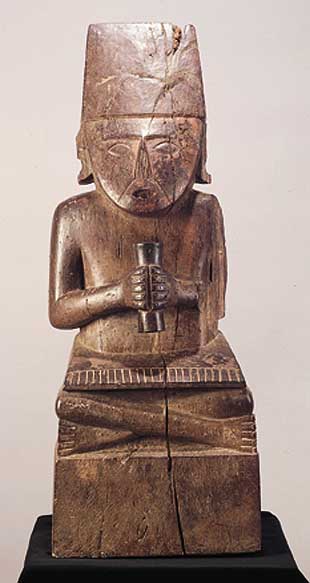|
The centre of the Chimú culture (850-1450 A.D.) was the city of Chan Chan in the Moche river valley. The ruins of the city cover almost an area of 20 square km. With the help of conquests and warfare the Chimú people made up a state which, during its glory days, ruled over a coastal strip of land of 1000 km that almost reached the northern border of Peru. The Chimú state was at its largest during its late stage (1350-1450 A.D.) having defeated the Sicán culture in the north. The Chimú state competed long also with the Inca state, which suppressed it round about the year 1450 A.D.
A mould was used in making Chimú ceramics, and the vessels were often made up of smaller components. Numerous vessel forms and decorative motifs share points of contact with the Moche ceramics. The Chimú vessels have been baked in a space deficient of oxygen, which is the reason for their characteristic dark colour.
The Chimú metallurgy reached an extremely high level. Copper, arsenic bronze, silver and gold were used as raw materials. Among others, soldering, casting, coating, decorating with stamp and chasing were mastered as to production and decorating techniques. Among other things, goblets, plates and many kinds of jewels and decorations were made from the precious metals reserved for the use of the aristocracy.
The Chimú textiles were mainly made from cotton, but also the wool of animals of the llama family was used. There were numerous production techniques and ways of decoration, and, among other things, feathers, plumes and joining metal decorations with a textile back were common.
|

Tall wooden statues like this, found in Chan Chan and its surroundings, were probably ornaments which were placed in wall niches of principal
buildings. © Museo Arqueológico Rafael Larco
Herrera, Lima, Peru (Cat. 236)
|

